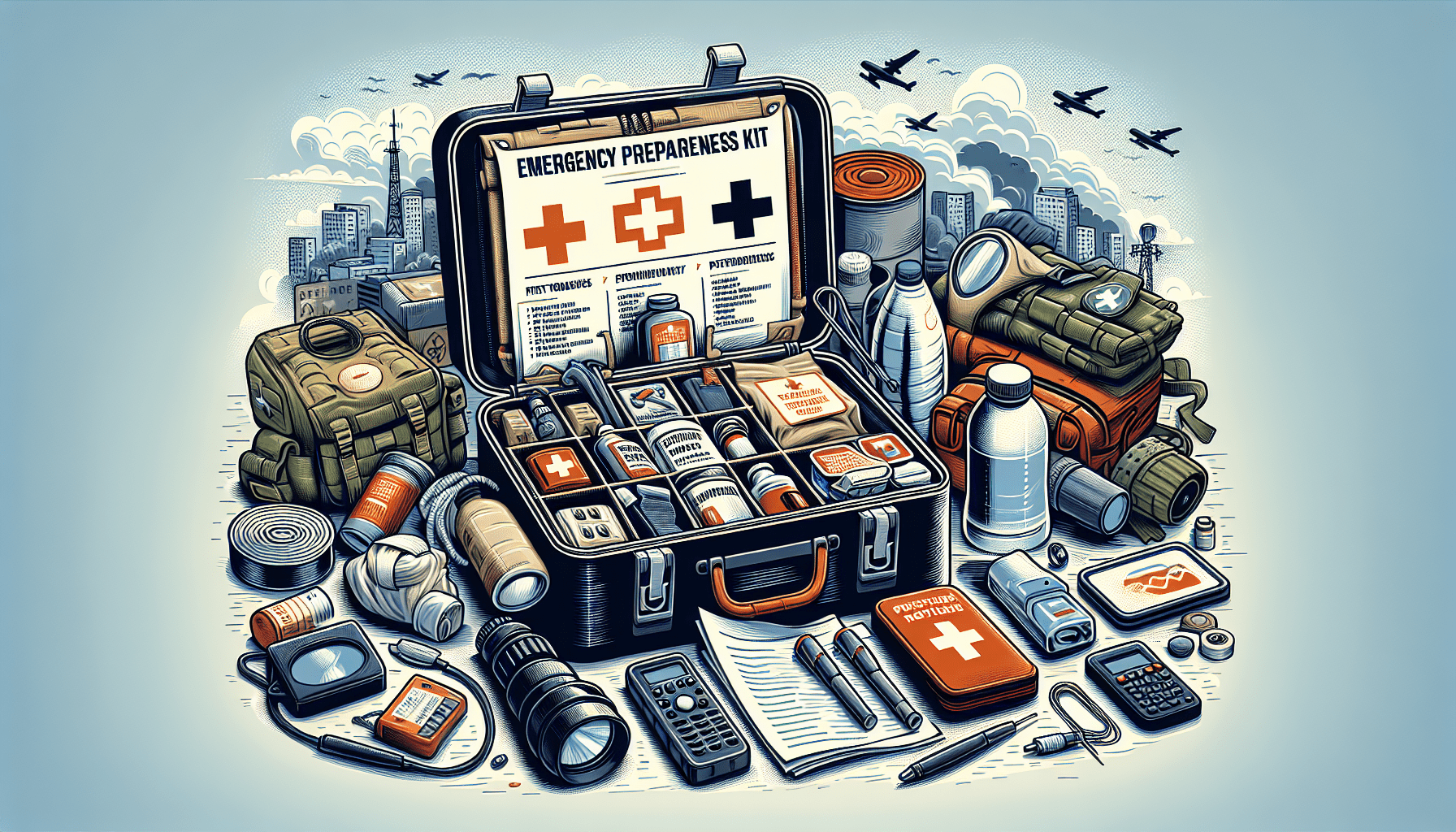In the unexpected event of an emergency, it’s crucial to be prepared and have a well-stocked emergency preparedness kit. This article will provide you with valuable insights on the essential items you should include in your kit to ensure your safety and well-being during difficult times. From water and food supplies to first aid essentials and important documents, this comprehensive guide will equip you with the necessary items to weather any storm and face emergency situations with confidence.

Water and Food
Water
When you’re preparing an emergency kit, one of the first things to consider is water. It’s absolutely crucial to have an adequate supply of clean drinking water in case of an emergency. The general rule of thumb is to have at least one gallon of water per person per day, for a minimum of three days. Keep in mind that you’ll also need water for cooking and sanitation purposes, so it’s always a good idea to have extra water on hand.
Non-perishable Food
In addition to water, you’ll also want to stock up on non-perishable food items. These are foods that don’t require refrigeration and have a long shelf life. Canned goods, granola bars, dried fruits, and nuts are some examples of non-perishable food items that are easy to store and can provide essential nutrients during an emergency. It’s important to regularly check the expiration dates on these items and rotate them out as needed.
Manual Can Opener
While it may seem like a small detail, a manual can opener is an essential tool to have in your emergency preparedness kit. Many of the non-perishable food items you’ll be stocking up on will be in cans, and without a way to open them, you’ll be left hungry. Make sure to choose a sturdy can opener that can withstand regular use.
First Aid Supplies
Bandages
In any emergency situation, there’s always the possibility of injuries. That’s why it’s crucial to have a variety of bandages in your first aid kit. Choose assorted sizes and types, such as adhesive bandages, gauze pads, and elastic bandages, to cover different types of wounds.
Antiseptic Wipes
To prevent infection and sanitize wounds, it’s essential to have antiseptic wipes in your first aid kit. These wipes are pre-moistened with antiseptic solutions that help kill bacteria and keep wounds clean.
Gauze Pads
Gauze pads are an essential component of any first aid kit. They can be used to cover wounds, apply pressure to stop bleeding, and protect injuries. Make sure to choose a variety of sizes to accommodate different types of wounds.
Adhesive Tape
To secure dressings in place, adhesive tape is a must-have in your first aid kit. It’s versatile and can be used to secure gauze pads, bandages, and other first aid supplies.
Pain Relievers
When dealing with injuries or discomfort, pain relievers can offer much-needed relief. Include over-the-counter pain relievers like acetaminophen or ibuprofen in your first aid kit to address headaches, muscle aches, and other minor pain.
Antibiotic Ointment
Antibiotic ointment is useful for preventing infection in wounds. It can be applied to cuts, scrapes, or burns to keep them clean and promote healing. Look for options that contain ingredients like bacitracin or neomycin.
Scissors
Scissors are an essential tool in any first aid kit. They can be used to cut tape, gauze, clothing, or other materials in emergency situations. Choose a pair of small, sharp scissors that can easily fit into your kit.
Tweezers
Tweezers are useful for removing splinters, ticks, or other foreign objects from the skin. They’re also handy for handling small items or performing delicate tasks. Choose a pair with a pointed tip for precision.
Disposable Gloves
Disposable gloves are crucial for preventing the spread of infection and protecting yourself and others when providing first aid. Opt for latex-free gloves to accommodate individuals with latex allergies.
Thermometer
A thermometer is a vital tool for monitoring body temperature, especially in case of illness or fever. Choose a digital thermometer for its accuracy and ease of use.

Light and Communication
Flashlights
In case of a power outage or when visibility is limited, having a reliable flashlight is essential. Keep at least one flashlight in your emergency kit and make sure to have spare batteries on hand.
Batteries
To power your flashlights, radios, and other electronic devices, it’s important to have extra batteries in your emergency kit. Make sure to choose the correct type and size for your devices and regularly check the expiration dates.
Portable Radio
A portable radio can provide you with crucial information during an emergency, such as weather updates, evacuation orders, or news. Opt for a battery-powered or hand-cranked radio that doesn’t rely on electricity.
Whistle
A whistle is a simple yet effective tool for attracting attention in an emergency situation. It can help rescuers locate you if you’re lost or trapped. Keep a whistle in your emergency kit and teach everyone in your household how to use it.
Cell Phone Charger
In today’s digital age, staying connected is vital during an emergency. Ensure you have a cell phone charger in your kit, preferably one that can be powered by alternate sources like a car charger or solar panel.
Emergency Contact Numbers
Include a list of emergency contact numbers in your kit. This should include local emergency services, your family doctor, and any other important contacts such as close relatives or friends.
